
'Lost'
A sobering retrospective looking at some of Blackpool’s lost buildings. This narrative with its own photographs was featured in Stanley Pak Visitor Centre during Summer 2013. Written by Ted Lightbown, Local Historian. Photographs used on the website are, as marked, from Tony Sharkey in Blackpool Central Library Local History Section and from Ted Lightbown, as published in his book 'Blackpool Through Time'.
Introduction
A look back at buildings that have been lost to Blackpool in recent years. Some are well-remembered and their loss is still felt, whilst others are largely forgotten. The reasons for their demolition are varied – progress (?), commercial pressures, social changes, fashion, redundancy, poor maintenance and fire, coupled with failure to appreciate their architectural and aesthetic qualities or historical significance.
It may be thought that we now know better and the worst losses would not happen today. This is not necessarily the case – it very much depends on the right people being better informed.
Derby Baths
As the loss of the Palace fades from memory, that of the remarkable Derby Baths, which stood at the corner of the Promenade and Warley Road until 1990, has replaced it as the most often mentioned.
Its demolition was hugely controversial at the time, but an attempt to have it listed failed. Photographs speak for themselves – it should never have happened.
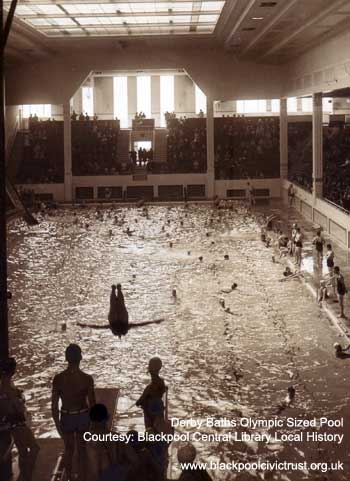
The Victoria Promenade
In 1837 the Victoria Promenade opened on Victoria Street, comprising 7 ground floor shop units, above which was an assembly hall, regarded as Blackpool’s first place of entertainment.
That alone might have been grounds for its preservation, but, during demolition in 2000, original plasterwork was exposed, including Ionic capitals.
In 1933 the extraordinary Little Vic pub was created in the eastern end of the building.
The Little Vic
The Little Vic’s facade was a blend of Spanish Colonial and Art Deco styles. It was designed by the architect J. C. Derham, who, 3 years earlier had created the Winter Gardens’ Olympia building, followed by the Spanish Hall suite of rooms.
As with those, Andrew Mazzei was engaged to create the Little Vic’s interior, again with a Spanish theme. The bell tower was removed in the 1970s, ensuring that an application to have the building listed failed shortly before it was demolished for bland shop premises in 1989.
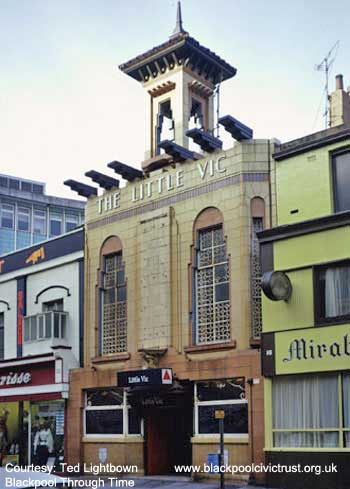
The Palace
The Palace opened on the Promenade alongside the Tower in 1899 as the Alhambra, a lavish entertainment complex. Following financial problems, it was taken over by the Tower Company, which re-launched it as the Palace in 1904.
The Tower Company immediately engaged Frank Matcham to re-work the interiors in an effort to create the same kinds of lavish interior they had just commissioned in the Tower Ballroom and Circus. It is still remembered for its beautiful ballroom, its variety shows and cinema.
By the late 1950s, it was becoming apparent that television and changes in taste were seriously affecting the popularity of live entertainment and that there was over capacity at Tower Company’s venues. As a result, the decision was taken to demolish the Palace. Demolition took place from the beginning of 1962 and a Lewis’s store opened on the site in 1964. Its loss is still lamented, but if the Palace had been retained, another of the Tower’s venues would have gone – perhaps the Grand Theatre or the Winter Gardens.
Christ Church
One of the greatest architectural losses to the town was that of Christ Church on Queen Street. The church was designed in the Decorated Gothic style by the architect J. Medland Taylor and opened in 1866.
It featured multi-coloured brickwork with panels of pebbles in between. Aisles were added in 1874, at which time its small round tower was moved to the east of the transept. Dwindling attendances and its proximity to St. John’s Church sealed its fate and, despite a campaign to save it, the church was demolished in 1982 and eventually replaced by a Job Centre.
Photo of Christ Church with Blackpool Civic Trust members near the entrance:
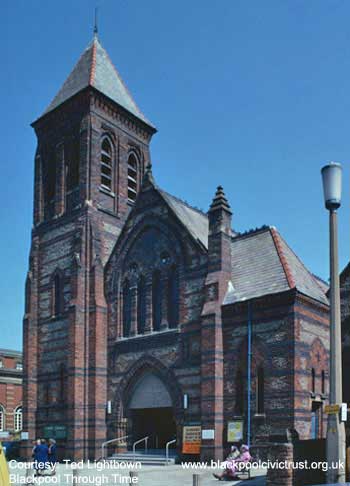
Church of Christ Scientist
The Church of Christ Scientist was erected on Whitegate Drive in 1928, designed by the prolific local architect Halstead Best in a striking contemporary take on the classical style. A dwindling congregation led to the site being re-developed as flats in 1987, the adjacent hall becoming the church.
Collegiate School
Opened as the Girl’s Secondary School in 1925 and designed by J. C. Robinson, the school at the corner of Forest Gate and Beech Avenue was better known as the Collegiate, but, confusingly, was latterly called both Knowle and Tyldesley before closing in 1985 to be replaced by flats.
Co-op Emporium
Blackpool Co-operative Society’s flagship Emporium of 1938, incorporating the Jubilee Theatre, stood on Coronation Street.
The rise of big high street names resulted in its demolition in 1988 for a planned shopping centre. However, its site remained a hole in the ground until eventually becoming a car park. The site was only properly developed when the Hounds Hill Centre was expanded to include the Debenham’s Store.
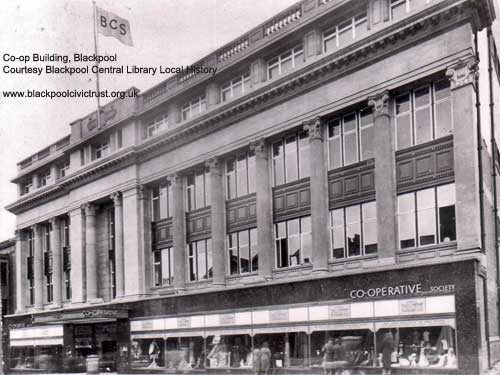
Baptist Church
The Gordon Memorial Baptist Church of 1927 on Forest Gate was demolished in 2007 for flats and a smaller church building.
Grosvenor Hotel
The Grosvenor Hotel at the corner of Cookson and Church Streets dated from 1874, but it was demolished, along with adjacent properties, for a car park in 2007.
Sun Parlour
The attractive sun parlour and bandstand at Bispham was designed by the Borough Architect, J. C. Robinson. Its removal about 2000 went unreported.
Hippodrome
The Hippodrome cinema, Church Street, had opened in 1895 as the Empire Theatre. Designed in the French renaissance style and executed in red brick with terracotta details, the building was key landmark on the western edge of the town centre. In 1962 it was largely demolished for the ABC Theatre, more recently a nightclub.
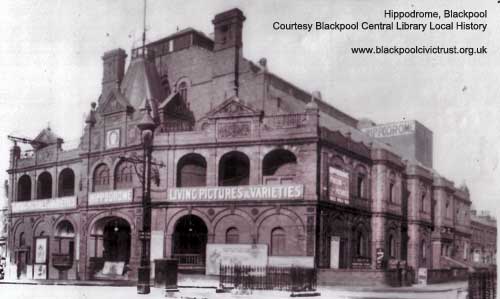
Manchester Hotel
The Manchester Hotel was rebuilt in the modernist style in 1936 to the design of J. C. Derham, who died that year. The use of vertical emphasis and detailed faience banding were characteristic of Derham’s work. It was altered in the 1960s and rebuilt in 1996.
Kent Tower
Looking like something out of Flash Gordon, Kent Tower, a sewage pumping station, was erected on the promenade at Anchorsholme in 1939. Its design is attributed to J. C. Robinson. It was taken down in 1982.
Gazette Office
The Gazette Office on Victoria Street, designed by Halstead Best, was built in 1934, when faience was the favourite cladding for such buildings. Halstead Best was one of Blackpool’s most prolific architects in the 1930’s and many of his buildings survive. This building was replaced by shops in 1987.
South Shore Baths
When opened in 1923, the Open Air Baths at South Shore were the largest in the world. The pool itself is attributed to the Borough Surveyor, Francis Wood, but J. C. Robinson designed the impressive faience-clad edifice around it.
In 1935 new changing rooms were added. Records show high attendances before the war, but, by the 1980s, holidaymakers were becoming used to the waters of warmer climes, and the Baths had a reputation for cold water. They were demolished in 1983 for the Sandcastle water complex.
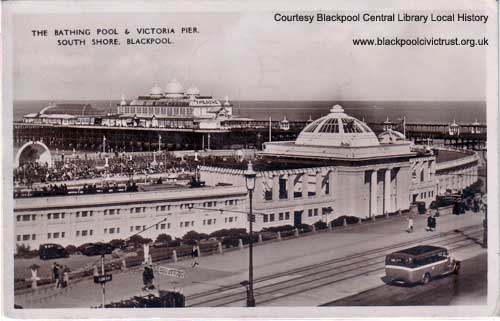
Booth’s
E.H. Booth’s handsome store stood opposite the Cenotaph, having opened in 1908. It is remembered for its Italianate buff terracotta façade. It was replaced by a bland cinema and bier kellar in 1972.
Lost Bits
Even if a building has survived, it can still have lost important original features, possibly through poor maintenance or unsympathetic alterations.
Domes, spires and other decorative features are particularly vulnerable. Often, the cheaper option to replace them with flat roofs, and contractors will no doubt justify their removal by asserting that the building will be given “clean lines.” So we find that the Tower building no longer has its turrets and domes that on Olympia’s corner tower went about 1950.
The former gateposts of Layton Hall, arguably the oldest architectural features in Blackpool, were donated to Stanley Park in 1927. In the 1980s they were re-erected with little regard to their original appearance, and more recently the pineapple tops have been stolen.
The spire of Blackpool Town Hall was removed in 1966 and the gold mosaic dome of the Cherry Blossom Hotel went in the 1990s.
New South Promenade
In the mid-1920s, Blackpool’s sea defences, and coastal tram and carriage way were extended from Balmoral Road to Starr Gate and, in the process, the coastline was pushed 400 feet further west. Apparently inspired by recommendations of Thomas Mawson and Son, much of the design and architectural work was by the Borough Surveyor’s Department and its chief architect J. C. Robinson.
The main architectural features were sunken gardens, a model yacht and paddling pool at Harrow Side surrounded by classical columns and shelters, and several large circular shelters with roofs of Westmorland slate. An additional pylon, with weather vane, in reality a ventilation shaft, was added c1939/40.
Talbot Hotel
The Talbot Hotel, built opposite the site of the Railway Station in 1845, was an attractive building which featured a facade of small beach pebbles. It was demolished in 1968 and is remembered for its annual bowling handicap competition held behind on its green.